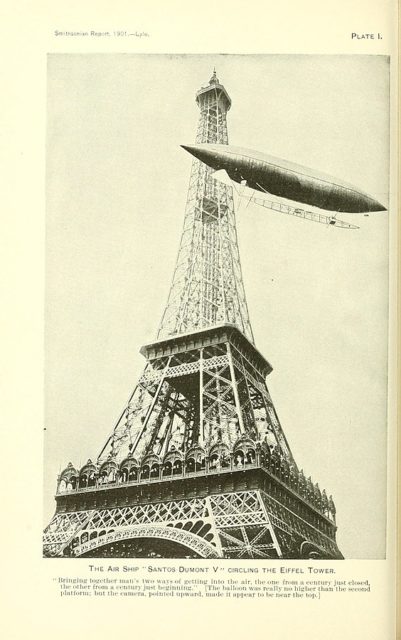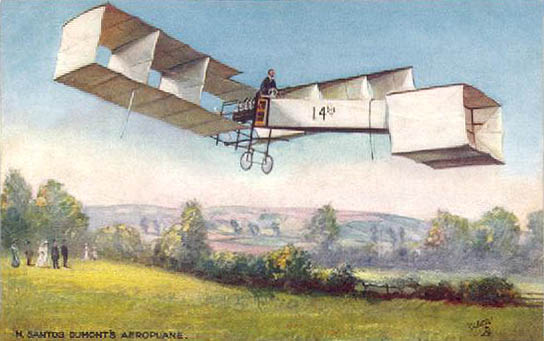“Oh, yes. Then men would be truly free. From the air, there are no boundaries. There could be no more war because the sky is endless. How happy we would be, if we could but fly.” -Terry Pratchett, Men at Arms
On October 19, 1901, Alberto Santos-Dumont, the 28-year-old heir to a wealthy family of coffee producers in Brazil and a recent graduate of aeronautical studies in Paris, made the first successful flight from Parc St. Cloud to the Eiffel Tower in his “Santos-Dumont No.6” dirigible balloon to win the Deutsch de la Meurthe prize. The prize consisted of 100,000 French francs, which he used for further research and development in the field of aviation and aircraft construction. He was absolutely sure that air travel would bring long-lasting peace to the world.
Everything he ever did, all his invention and designs, were patent free and freely published for everyone to examine and use to contribute to a greater humanity.

In 1932, after having witnessed some of his designs used in warfare during São Paulo’s Constitutionalist Revolution, he hanged himself.

Born on July 20, 1873, in the village of Cabangu in Palmira, Brazil, Alberto Santos-Dumont was raised in a wealthy environment by a highly inventive father. Due to his labor-saving inventions, his father, Henrique Dumont, earned a lot of money for the family and with time came to be known as the”Coffee King of Brazil.”
Being raised by such a dedicated and successful engineer was clearly advantageous for Alberto, for he needed only a couple of years to get from his first flight balloon to the first flight in his very own fixed-wing airplane.

In his early career, he designed, developed, and flew hot-air balloons and early versions of lighter-than-air dirigible aircraft, or what we now refer to as Zeppelins. Inspired by his first successful balloon flights, Dumont believed he could do more and designed a steerable balloon, what later became identified as a non-rigid airship, which would allow people to fly through the air rather than just float along the wind.

On August 8, 1901, he made his first attempt to take the trip from the Aéro-Club de France at Parc Saint Cloud to the Eiffel Tower, though it was unsuccessful. The trip, taken in one of his first sound airships, Santos-Dumont No.5, ended when it failed to fly over the roof of the Trocadero Hotel and crashed, leaving him stuck in the basket hanging from the side of the hotel.

After making some changes to his design, he managed to complete the round trip just 10 weeks later on October 19. He decided to donate the 100,000 francs in prize money to the poor people of France, and used a further 125,000 francs, awarded to him along with a gold medal from the government of his native Brazil, to develop his research.

And so he did, for only four years later in 1905 he finished his first fixed-wing aircraft design, as well as a model of a helicopter. A year later, on October 23, 1906, Dumont piloted his newest “baby,” the 14-bis, over a large crowd of witnesses at the fields of Paris’ Château de Bagatelle in the Bois de Boulogne. He flew 60 meters, averaging about five meters of altitude. Only a month after that, he managed to travel 220 meters in 21.5 seconds, setting the first world record acknowledged by the Federation Aeronautique Internationale.
He resumed investing his time in research and development of heavier-than-air aircraft, although he never ceased to work on non-rigid airships as well. His last design is known to be the Demoiselle monoplane. Used at first by Santos-Dumont for personal transport, it started to be massively produced by the Clement-Bayard company after he started working with Adolphe Clément in 1908 and came to be the world’s first recorded series production aircraft.

It was in this plane Dumont made his final flight on January 4, 1910. He was forced to crash-land when a bracing wire snapped, then in March 1910 he announced his retirement from aviation. He secluded himself in his house, leading many to speculate he had suffered a nervous breakdown from overwork. Later it was confirmed he was suffering from multiple sclerosis, which drove him towards a serious long-lasting depression.

After WW I started in 1914, his German-made telescope and his unusual accent prompted serious accusations, including that he was a German spy tracking French naval activity. Upset by the allegation and feeling betrayed by the state he had invested so much in, Santos-Dumont burned all his papers and design plans. He spent much of his subsequent years in Swiss and French sanatoriums and health institutions, feeling beaten down both by his illness and the betrayal.
In 1931, Santos-Dumont’s nephew traveled to Switzerland and brought him back to Brazil. Seriously ill and not able to cope with the fact that what he had envisioned and designed was used in the bombing of São Paulo during the Constitutionalist Revolution of 1932 in his home country, he hanged himself on July 23, 1932 in the city of Guarujá.
Today he is a national hero in Brazil, where he is recognized as one who preceded the Wright brothers in envisioning a practical airplane. In fact, the United States at one time recognized Dumont as the father of aviation. After his death, his heart was placed in a golden globe and now lies preserved at Brazil’s National Air and Space Museum.
